
Previous Shows
March 2004
Hour 25 Home Page
This Week's Show
Upcoming Shows
Audio Index
Current Calendar
Last Month's Calendar
On-Going Events
Authors on Tour
Literacy Education
Hour 25 Background
Links
Index to our previous shows
Howard V. Hendrix Listen to this show
|
On Sunday - March 21st, 2004 - our guest was author Howard V. Hendrix. Howard is no stranger to the Hour 25 audience, this being his third appearance on the on-line edition of Hour 25. We had the chance to sit and chat with him about his books and the art and craft of writing while at the WorldCon in San Jose some time back. During that conversation he spoke about a new book he was working on, The Labyrinth Key. We decided that now would be a great time to run this interview since The Labyrinth Key is starting to appear on bookstore shelves. {We plan on speaking with him again soon so we can talk more about his new book. You can consider this interview to be the 'pre-game show' for that book.} |
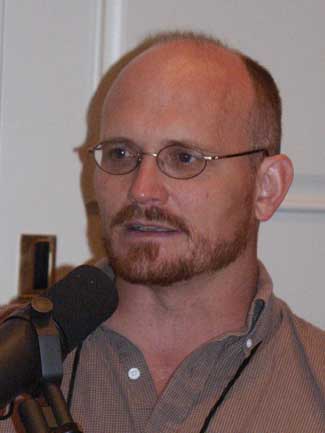
|
|
|
I always enjoy talking about writing with Howard because he has a rare gift for explaining the art of writing and deconstructing what it is that authors do when they do what they do when they're working. This might have something to do with his background as a University Professor, but then again most of my college teachers weren't as good as Howard when it comes to explaining things. {I guess we'll just have to classify him as a rare talent and let it go at that.} Howard is a writer of no small talent. His books combine thoughtful speculation along with complex and carefully crafted characters driven by logically developed plots. His books are unique, interesting and rewarding reads. Although he has a Ph.D. in Literature, his undergrad background is in biology and so he fills his books with the most wonderfully interesting scientific speculations. {In other words, his books have all the things I'm looking for when I sit down for an evening's reading.} I won't try and describe his books to you, just take it from me that they are always excellent and provide a good return on the investment of the time you spend reading them. His books are all most highly recommended. |
||
 |
 |
 |
 |
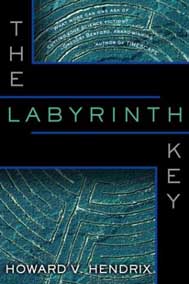 |
Dateline: Mars
NASA is releasing all of the images from the two Mars Exploration Rovers almost as soon as they arrive at JPL. The raw images for the Spirit rover can be found at this Web Page and raw images for Opportunity can be found here. The images that have been released to the press, along with animations and other images, can be found here.
|
Opportunity |
  Image Credit: NASA/JPL |
|
The two images above present data acquired by the rover's Thermal Emission Spectrometer. This data can be used to identify the presence of specific minerals on the Martian surface. In the images above, the red colors indicate the presence of about 20% Hematite and the blues indicate the absence of Hematite. Scientists will be using these and other similar mineral abundance maps to investigate the geologic processes that have shaped the Martian surface. |
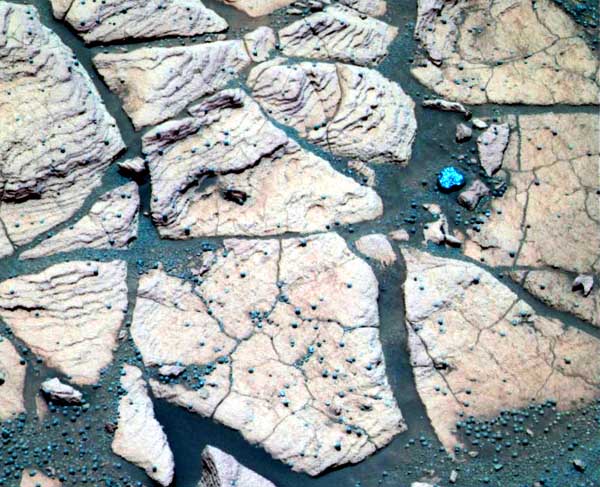 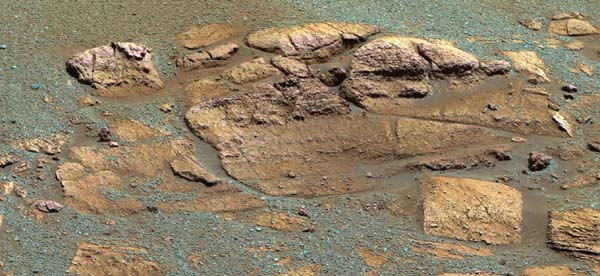 Image Credit: NASA/JPL |
|
Blueberries everywhere! The two false-color pictures above show the Martian surface covered by the now famous blueberries. Analysis of these objects suggests that they are geologic features called concretions, which form when minerals precipitate out of wet sediments. This, and other lines of evidence, indicate the presence of large amounts of water on the Martian surface in the past. {Please note, that the colors shown in these pictures are not the ones you would see if you were on Mars yourself, but are artificial colors designed to bring out mineralogical details in the rocks.} |
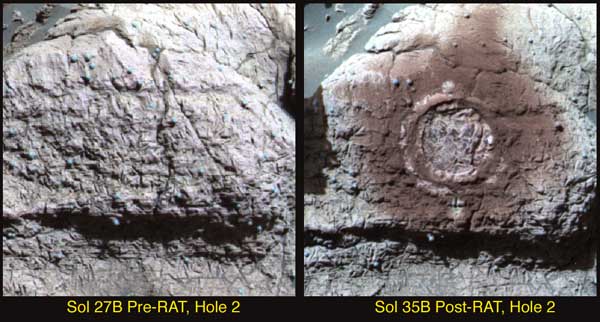 Image Credit: NASA/JPL |
|
Here's a before and after closeup of a rock that that had a bit of its surface removed by the Rock Abrasion Tool (RAT). |
 Image Credit: NASA/JPL |
|
Above are images of an eclipse of the sun by the Martian moon Phobos. Unlike the Earth's Moon, Phobos is too small and too close to Mars to completely cover the disk of the Sun during an eclipse. |
|
Spirit |
 Image Credit: NASA/JPL |
|
The Road Behind Above you see the tracks left by Spirit as it drove across the Martian desert. If you look closely at the point where the tracks nearly vanish into the horizon you will see a small dark object. This is the landing stage that delivered the rover to the Martian surface almost two months ago. |
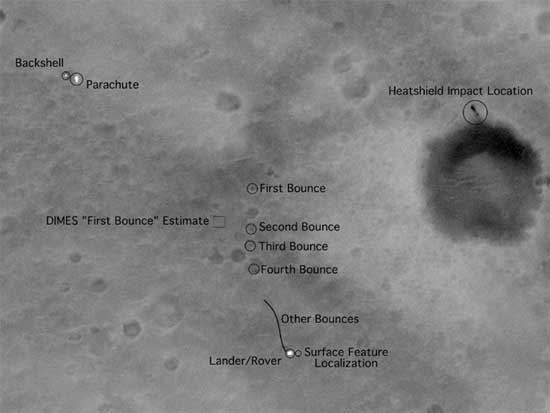 Image Credit: NASA/JPL |
|
The image above shows the local area where Spirit has been roving, including the impact crater named Bonneville. Over the last few weeks Spirit has been driving toward this crater in hopes of getting a glimpse inside it so that scientists will have a better understanding of the geology of Mars. |
 Image Credit: NASA/JPL |
 Image Credit: NASA/JPL |
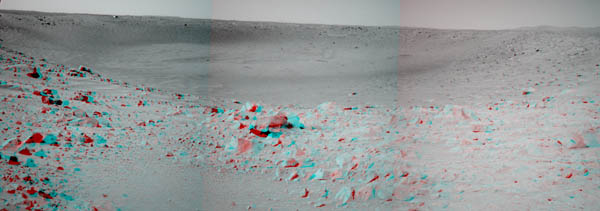 Image Credit: NASA/JPL |
|
Above are three views of the interior of Bonneville crater, first in black and white, then in color and finally in 3D - don't forget your red-green glasses for this last one. Scientists had been hoping that the interior of this crater would show them some of the local bedrock but that does not seem to be the case. When they understand why they didn't find what they expected to find, the scientists will have unravelled yet another clue to the geologic history of the Red Planet. |
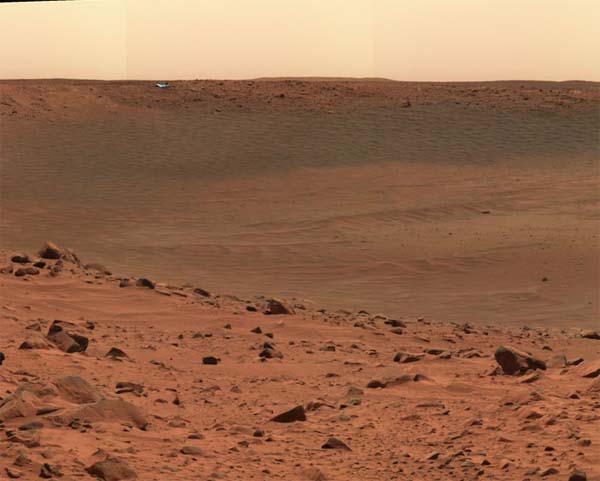 Image Credit: NASA/JPL |
|
And here you have a closeup of the interior of Bonneville crater. Small sand dunes cover the crater's bottom and outcrops of rock line its edges. If you look over on the left side of the far wall of the crater you will see the heatshield from the spacecraft that delivered the lander to Mars. |
 Image Credit: NASA/JPL |
|
After taking those pictures of Bonneville crater the rover drove a few feet to the right and discovered these drifts of sand. |
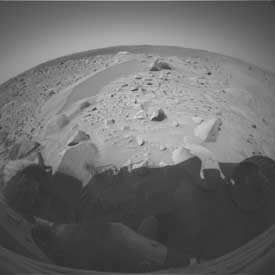 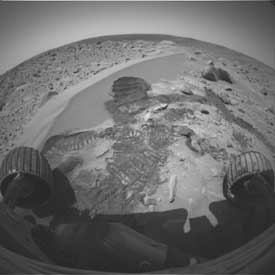 Image Credit: NASA/JPL |
|
Spirit later ran one of its wheels over the sand drift so that it could expose materials that had not been weathered by the Martian atmosphere. Understanding how various weathering processes work on Mars is one of the things that the scientists are hoping to learn as a result of their explorations with the rovers. On the left you see the sand drifts as the rover found them and on the right you see those drifts after the rover had exposed samples of unweathered soil. |
  Image Credit: NASA/JPL |
|
The left hand picture above shows a Martian rock after Spirit has used its Rock Abrasion Tool (RAT) to cut away the weathered outer layers of the rock. On the right hand picture above you see a color picture of the sand drifts and the marks left by the rover's wheels. |
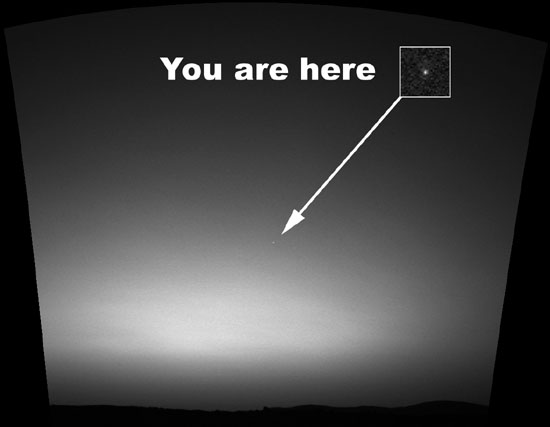 Image Credit: NASA/JPL |
|
On the 63rd Martian day after landing, Spirit photographed the sunset and caught the image of a small point of light that was following the Sun as it dipped below the horizon. That point of light was the Earth. I hope you were smiling on that day, 'cause you're in this picture. |
 Image Credit: NASA/JPL |
|
The Path Ahead The Columbia hills lie off in the distance as Spirit moves beyond Bonneville crater. Scientists hope that the rover will be able to reach those hills before the wear and tear of being on Mars brings this mission to a close. Don't you just wonder what lies on the other side of those hills? I know I do! |
Listen to this show | |
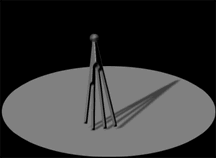
|
|
If you enjoyed this show and would like to know when other interviews are uploaded to the Hour 25 web site, then send an email to me at wwjames@earthlink.net and I will add your name to the free Hour 25 Newsletter mailing list. That way you'll get a brief notice in your email every time a new show gets uploaded to the web.
Links for more information relating to this week's show
|
Howard V. Hendrix
Space News - Mars For On-Going Updates on Space News Space News - The Columbia Accident - On-Going The Columbia Accident Report The Smoking Gun The Management Problem Concerning Future Developments On-Going Coverage and Reference Sources ISS News |
Copyright © Warren W. James, 2000-2004. All rights reserved.